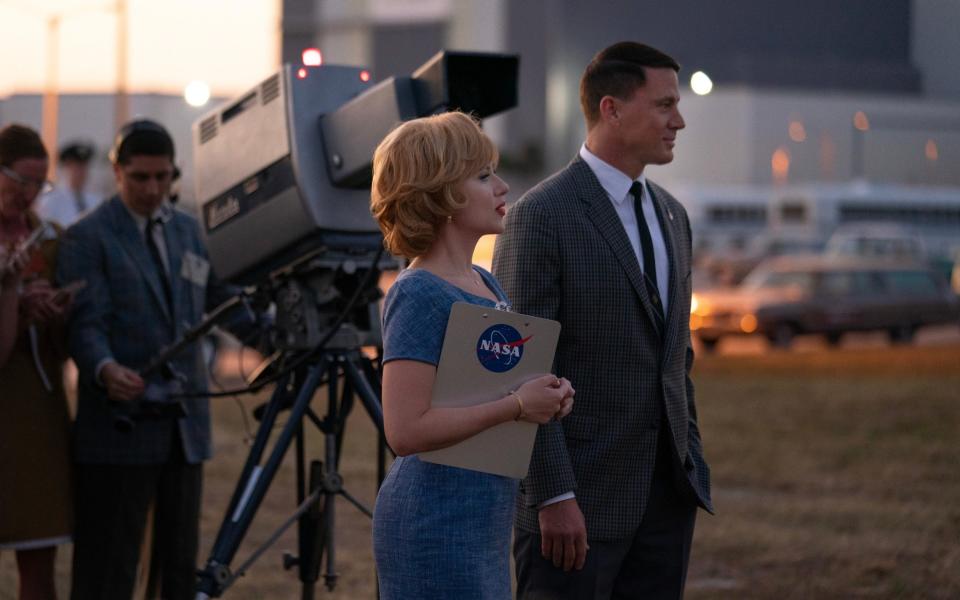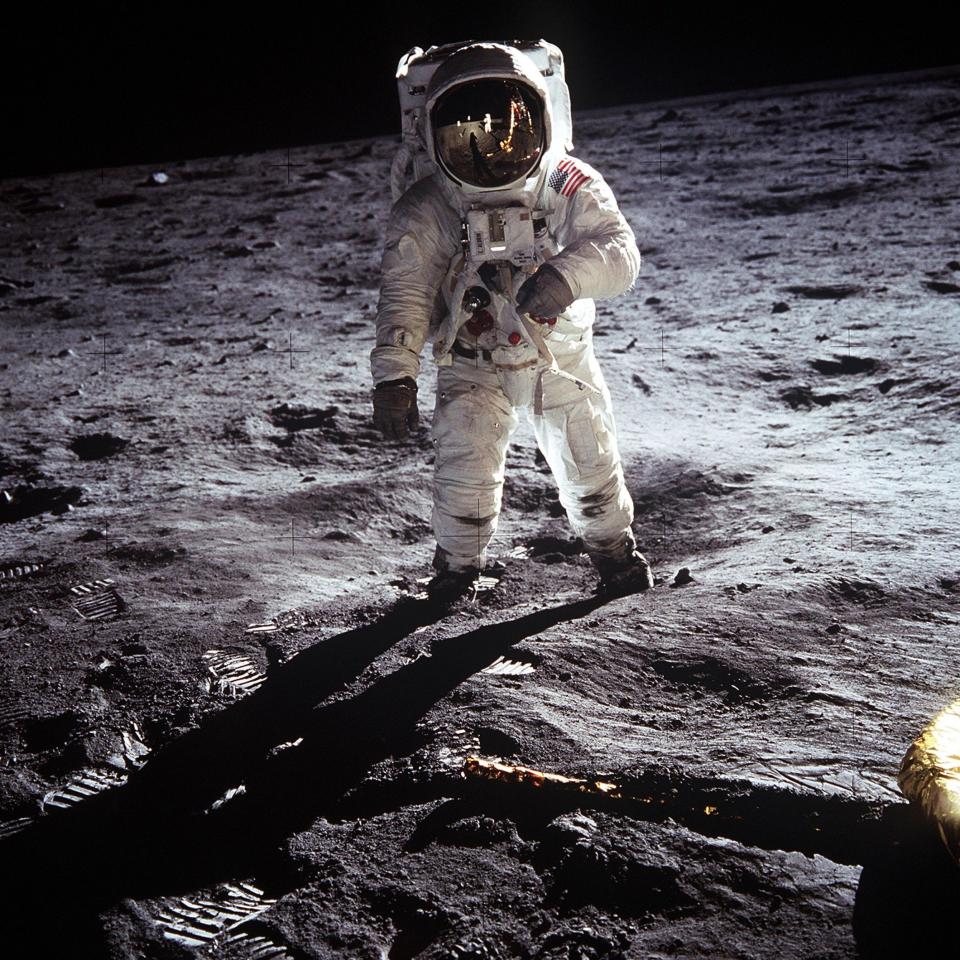In September 2002, the astronaut Buzz Aldrin – the second man to walk on the Moon – was confronted in Beverly Hills by a camera crew led by Bart Sibrel. Sibrel, the creator of several documentaries alleging that the Moon landings never happened, shoved a Bible at Aldrin and demanded he swear on it that he wasn’t lying about walking on the Moon, before calling him “a coward and a liar”.
In response Aldrin, then 72, punched Sibrel in the face. Aldrin’s angry reaction didn’t reassure anyone, though, and just fuelled a new wave of conspiracy theories. The central claim: the Apollo landings were a gigantic scam, perpetrated on the whole world by the American government.
Humans first landed on the Moon on July 20 1969. More than half a billion people watched on television as Neil Armstrong and Aldrin took their first steps on the arid surface. They left behind an American flag, a patch honouring the fallen crew of Apollo 1, and a plaque that read: “We came in peace for all mankind.” The sixth Apollo mission to land humans on the Moon concluded three years later. The Moon has not been visited by astronauts since December 1972.
By 1976, doubts were already creeping in. That year, Bill Kaysing, a former US Navy officer who had worked for one of Nasa’s rocket manufacturers, self-published a pamphlet titled We Never Went to the Moon: America’s 30 Billion Dollar Swindle. In it, Kaysing pointed to unexplained optical anomalies – the absence of dust clouds or blast craters around the lunar module, and the lack of stars in surface photographs – to suggest that the footage was created in a studio.
Such hypotheses have proliferated into a body of literature that shades into hallucinatory weirdness: theories on the demonic nature of UFOs, astral projection, ancient aliens genetically engineering the human race, and other oddities.
The hoax is of such a vintage that it’s become a staple of popular culture. Already in 1971, James Bond was depicted stumbling upon a Nasa film set made to look like the lunar surface, before giving chase in a Moon buggy, in Diamonds Are Forever. In this month’s Fly Me to the Moon, Scarlett Johansson plays a marketing genius hired by Nasa to film a fake landing in case the Apollo 11 mission fails.
With that kind of pedigree, the Moon-landing hoax can’t just be explained away as a form of modern-day “fake news” that blooms and fades on social media. Scepticism about the Apollo space programme was swirling long before the advent of the internet, beginning almost immediately after the landings themselves.
In turn, a great deal of effort has been expended over the decades trying to use evidence to dispel the conspiracy theories. But attempting to debunk them logically is to misunderstand what such claims are communicating.
Today, one in eight Americans think the Moon landings were staged – as do one in 11 Britons. Why won’t we all just accept the facts? Perhaps because most people aren’t interested in or persuaded by facts alone. We need only recall how, when Covid broke out, the educated classes demanded officials discard the existing pandemic action plan to see this extends well beyond those routinely accused of ignorance and emotional reasoning. Conspiracy theories make most sense when understood not as factual claims but as emotional stories – allegories – that exist in oblique relation to empirical reality. They convey diffuse, and sometimes prophetic, intuitions about the world.

The pandemic illustrates this again. Among the many conspiracies that circulated concerning the Covid vaccination programme, one common claim was that vaccines were really a covert programme to inject each of us with a microchip that would allow Bill Gates to track our whereabouts or even control our minds.
This is, we can safely say, not true. Conversely, though, the vaccination programme really was accompanied by the international rollout of digital “vaccine passports”, which link vaccination status to other biomedical data, as well as official state identifiers. And while it’s no longer in active use, this architecture now enables states potentially to track individuals’ movements, and to index freedoms previously taken for granted – such as travel or access to public spaces – to co-operation with who-knows-what future mandatory medical interventions.
However, this probably isn’t a sinister plot, whatever the conspiracists may say. It does nevertheless prompt us to read the conspiracy differently – poetically – interpreting “Bill Gates” as personifying a fusion of tech and governance interests, and the “microchip injection” as symbolic shorthand for the discomfiting sense that unknown technologies wielded by this figurative “Bill Gates” increasingly intrude into our physical, embodied lives. It’s fancifully expressed, but is it really so far from the truth?
The Moon-hoax conspiracy also makes sense as allegory, when we consider what the Moon landings symbolised in mid-century American culture and international politics. The “space race” between America and Russia stood, symbolically, for the competition between capitalist West and communist East: that is, between two ways of organising a mass industrial civilisation. Which social framework was better at delivering rapid, ambitious advances in real-world engineering and technological progress? The race to reach the Moon served as a proxy for this competition, by virtue of the sheer immensity of the goal, as well as its technical demands. For a living human being to leave the Earth’s protective envelope for the emptiness of space and walk on the surface of a celestial body took extraordinary financial, organisational and technical resources, not to mention tremendous courage and ambition.
Winning the space race, then, served as proof positive that the Land of the Free was a more fertile home for this kind of ambition and innovation than any command-and-control socialist regime. Putting the first man on the Moon wasn’t just a “giant leap for mankind”, as Neil Armstrong famously said. It was also a watershed moment in the Cold War.
What, then, to make of the sceptics who appeared in the midst of that mid-century American triumphalism to cast aspersions on its veracity? It perhaps reflects an early intuition that America’s long, slow drift away from the material and sociocultural conditions that enabled the space race had already begun at the moment it was won.
To build the lunar landers, the Apollo programme drew on American engineering talent and heavy industry that has since been shredded by globalisation, outsourcing and changing educational priorities. By the last Apollo flight, this process was well under way: US manufacturing was already declining from its 1957 peak of more than a quarter of American GDP – and today it languishes at about 11 per cent.


Meanwhile, the sense of common American purpose that drove the project has also fractured. In a 2001 interview, Armstrong praised the mission’s low rate of engineering failure, which he attributed to a sense of common endeavour and striving towards excellence spread across the “hundreds of thousands” of engineers, makers and fitters involved in the mission. Among this number, he said, “every guy in the project, every guy at the bench building something, every assembler, every inspector, every guy that’s setting up the tests, cranking the torque wrench, and so on, is saying, man or woman, ‘If anything goes wrong here, it’s not going to be my fault, because my part is going to be better than I have to make it.’”
Since the Moon landings, though, the sense of civic unity that enabled this degree of co-ordinated striving towards excellence has become increasingly contested. No longer taken for granted as core American attributes, instead national pride and cultural homogeneity have come increasingly to be seen as actively inimical to American values. And this has occurred, the historian Christopher Caldwell argues in The Age of Entitlement (2020), as a consequence of the many state-mandated measures to impose equality by fiat, which have mushroomed since the Civil Rights Act of 1964. Though he does not endorse the segregation the act sought to dismantle, in Caldwell’s view its ratification in effect created a “rival Constitution”, which implicitly treats civic unity and patriotism not as necessary preconditions for high civilisation, but as obstacles to radical equality.
Other distractions have displaced the 20th-century drive for industrial innovation: though there are exceptions, such as Elon Musk’s SpaceX, there has been a notable shift away from trying to reach outer space towards a preoccupation with virtual worlds. Peter Thiel, the Silicon Valley investor, argues that this has been enabled by the digital revolution, whose advances serve, in his view, as a distraction from the stagnation and decline of real-world technological progress. In his notorious formulation: “We wanted flying cars, instead we got 140 characters.”
Understood against this backdrop, the eruption of scepticism about the Moon landings can be read as an early intuition that even at America’s crowning civilisational moment, the enabling conditions for that moment were already under threat. Deindustrialisation had already begun; the germinal form of “diversity, equity and inclusion” was already written into American law; the precursors of the internet were spreading.
Earlier this year, Bart Sibrel himself appeared on the wildly popular Joe Rogan Experience podcast. It’s not difficult to see how modern America might struggle to believe that their forebears were capable of the kind of engineering inventiveness, courage and large-scale co-operation required to make the Apollo missions a reality.
At its peak, Apollo involved some 400,000 people, across thousands of institutions. Even the rockets were built across multiple locations. It was an extraordinary feat of co-ordination, achieved in an age before modern computer-design programmes or tools for instantaneous communication. By contrast, when in the 2000s California invited bids for construction of a high-speed rail line through the state, the French rail firm SNCF tendered a proposal – only to withdraw it in 2011 to work on a similar project in Morocco, whose government, the SNCF engineers declared, was less politically dysfunctional than California’s. Morocco’s high-speed railway began operating in 2018. California’s is still not completed.
It is unlikely that the America of today could muster the degree of co-ordination and industrial resources that put Armstrong and Aldrin on the Moon in 1969. Were I an American raised on the conviction that progress moves only in one direction, I too might conclude that, logically, these feats could not have been achievable half a century ago.
The most comforting conclusion, in other words, might be that the Moon landings were a hoax. The alternative is far bleaker: that the achievements of mid-20th-century America were the achievements of a different civilisation, one now as distant and mysterious as the Moon.
Fly Me to the Moon is in cinemas from Friday
Broaden your horizons with award-winning British journalism. Try The Telegraph free for 3 months with unlimited access to our award-winning website, exclusive app, money-saving offers and more.













